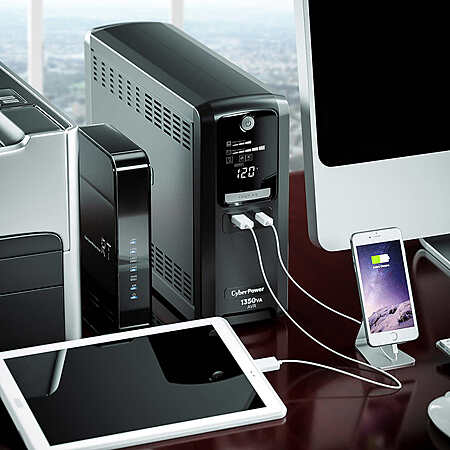expiredJames2012 posted Nov 27, 2021 02:32 AM
Item 1 of 5
Item 1 of 5
expiredJames2012 posted Nov 27, 2021 02:32 AM
CyberPower 1350VA Simulated Sine Wave UPS Battery Backup System
+ $5 S&H$90
$119
24% offCostco Wholesale
Visit RetailerGood Deal
Bad Deal
Save
Share







Leave a Comment
Top Comments
Sine wave wise, as far as i know with my research for a week, PC power supplies now days can handle either Pure and Simulated without any problems.
The claims about PC PSU need Pure are majorly talking about PSU 10yrs ago without standard like modern gold plat certificate. They only situation you need Pure is the electronics with sensitive wave requirements, which are medical equipment and laser printers etc, search what electronics need pure sine wave if you needed.
Also the premium Pure battery replacement after 3 year will cost a bit more than Simulated.
I am NOT against people purchasing the higher quality Pure, I'm just here to state that simulated UPS is better bang for the buck in terms of using it as PC UPS.
Compatibility issues with simulated sine wave are indeed far from a widespread issue, though a careful test might be recommended after giving the UPS a day or two to charge up. There are some risks to this test, but if you get 5-10 minutes of solid run-time you might expect the same in future real-world scenarios. I'll put a separate comment about my own recommendations regarding this issue.
One warning I'd add for an OLED TV is to check the peak power draw rating. I've seen OLED TVs rated for over 600W. This UPS is rated for a peak draw of 810W, and while an OLED would rarely reach peak draw often or for very long (unless you just stare at full brightness white screens all day?) you do want to ensure you have a decent overhead between your TV's potential peak draw and your UPS' peak load capacity. This is in part because you might need more than a couple of minutes to actually shut things down gracefully in the case of a power outage (and near peak load retail UPS times are indeed measured in minutes).
The specifications sheets for the two models suggest that the CP1350AVRLCD has denser batteries (9Ah vs 7Ah), giving it twice the runtime at peak load (and 50% more run time at half load). Of course, you could make this change yourself the next time you rotate those batteries out!
https://www.cyberpowers
https://www.cyberpowers
Good luck!
Jon
90 Comments
Sign up for a Slickdeals account to remove this ad.
Our community has rated this post as helpful. If you agree, why not thank MagentaKitten833
Sine wave wise, as far as i know with my research for a week, PC power supplies now days can handle either Pure and Simulated without any problems.
The claims about PC PSU need Pure are majorly talking about PSU 10yrs ago without standard like modern gold plat certificate. They only situation you need Pure is the electronics with sensitive wave requirements, which are medical equipment and laser printers etc, search what electronics need pure sine wave if you needed.
Also the premium Pure battery replacement after 3 year will cost a bit more than Simulated.
I am NOT against people purchasing the higher quality Pure, I'm just here to state that simulated UPS is better bang for the buck in terms of using it as PC UPS.
Sign up for a Slickdeals account to remove this ad.
I have a number of similar APCs, so still holding out for the updated Cyberpower pure sine wave 1350 or 1500 to make it to Costco. Perhaps in 2022...
Sine wave wise, as far as i know with my research for a week, PC power supplies now days can handle either Pure and Simulated without any problems.
The claims about PC PSU need Pure are majorly talking about PSU 10yrs ago without standard like modern gold plat certificate. They only situation you need Pure is the electronics with sensitive wave requirements, which are medical equipment and laser printers etc, search what electronics need pure sine wave if you needed.
Also the premium Pure battery replacement after 3 year will cost a bit more than Simulated.
I am NOT against people purchasing the higher quality Pure, I'm just here to state that simulated UPS is better bang for the buck in terms of using it as PC UPS.
Sine wave wise, as far as i know with my research for a week, PC power supplies now days can handle either Pure and Simulated without any problems.
The claims about PC PSU need Pure are majorly talking about PSU 10yrs ago without standard like modern gold plat certificate. They only situation you need Pure is the electronics with sensitive wave requirements, which are medical equipment and laser printers etc, search what electronics need pure sine wave if you needed.
Also the premium Pure battery replacement after 3 year will cost a bit more than Simulated.
I am NOT against people purchasing the higher quality Pure, I'm just here to state that simulated UPS is better bang for the buck in terms of using it as PC UPS.
Sign up for a Slickdeals account to remove this ad.
Everything else seems the same to me, otherwise. Wanted to see if I'm missing anything else here.
Leave a Comment